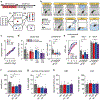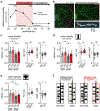Social experience in adolescence shapes prefrontal cortex structure and function in adulthood
- PMID: 38580810
- PMCID: PMC11567502
- DOI: 10.1038/s41380-024-02540-6
Social experience in adolescence shapes prefrontal cortex structure and function in adulthood
Abstract
During adolescence, the prefrontal cortex (PFC) undergoes dramatic reorganization. PFC development is profoundly influenced by the social environment, disruptions to which may prime the emergence of psychopathology across the lifespan. We investigated the neurobehavioral consequences of isolation experienced in adolescence in mice, and in particular, the long-term consequences that were detectable even despite normalization of the social milieu. Isolation produced biases toward habit-like behavior at the expense of flexible goal seeking, plus anhedonic-like reward deficits. Behavioral phenomena were accompanied by neuronal dendritic spine over-abundance and hyper-excitability in the ventromedial PFC (vmPFC), which was necessary for the expression of isolation-induced habits and sufficient to trigger behavioral inflexibility in socially reared controls. Isolation activated cytoskeletal regulatory pathways otherwise suppressed during adolescence, such that repression of constituent elements prevented long-term isolation-induced neurosequelae. Altogether, our findings unveil an adolescent critical period and multi-model mechanism by which social experiences facilitate prefrontal cortical maturation.
© 2024. The Author(s), under exclusive licence to Springer Nature Limited.
Conflict of interest statement
COMPETING INTERESTS
The authors declare no competing interests.
Figures





References
-
- Baumeister RF, Leary MR. The need to belong: desire for interpersonal attachments as a fundamental human motivation. Psychol Bull. 1995;117:497–529. - PubMed
MeSH terms
Grants and funding
LinkOut - more resources
Full Text Sources
Miscellaneous

